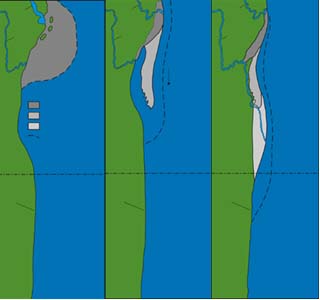
The sand is from the melting Wisconsin glacier. About 16,700 years ago, the Root River was a glacial meltwater stream in southern Wisconsin. It emptied into ancestral Lake Michigan near present-day Racine. The river dumped large quantities of sand and gravel from the melting glacier into the lake, forming a delta.
map caption
As the ice melted, waves began to erode the delta and move the sand along
the shore.
map caption
The waves carried the sand south where it was gradually thinned out to
form a long finger that hugged the lakeshore.
map caption
The sand reached Illinois about 4,000 years ago and continues to thin
out along the lakeshore moving south.
The Sand Ridges
The sand ridges that run parallel to the lakeshore in this area are
beach ridges. Each ridge was once a beach at the water’s edge.
The series of beach ridges formed as the water level of Lake Michigan
fell over time.
Sand dunes have formed on some of the beach ridges. Dunes are created
by wind-blown grains of sand. The grains travel until they hit an obstacle,
such as a rock, a piece of driftwood, or a blade of grass. As sand builds
up at the obstacle, it forms a dune.